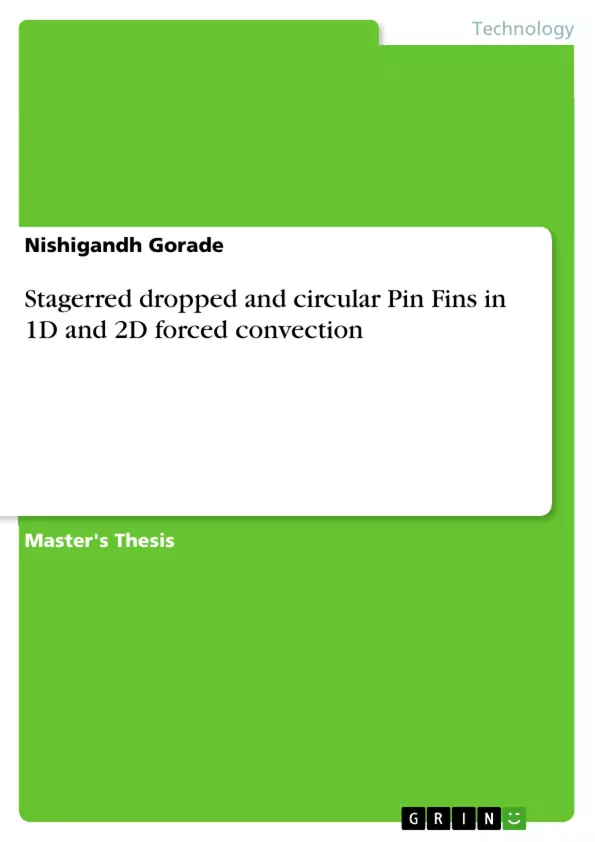In this experimental analysis of heat transfer variation and its enhancement of the dropped and circular shapes, staggered pin fin heat sink under constant heat flux condition are presented through a conducted experimental comparison between aluminium, stainless steel and iron materials with circular and dropped shaped pin fins.
A pin fin is fabricated from heat sink aluminium (Aluminium-Magnesium-Silicon Alloy), Stainless steel and ferrous material with a diameter of 10 mm. The Base plate is also same material and fins are mounted on a base plate with the help of a thread. Various trials were conducted on each material for choosing the best materials for more heat transfer. Also, to choose which is the best shape of pin fins i.e. circular or dropped for enhancing maximum heat transfer. Also, trials were conducted to find out from forced convection from 2D or 1D which is more capable to transferring heat transfer and therefore to choose the best flow of heat transfer model. The total comparison between circular and dropped shaped pin fins was performed in this experimental analysis. Finally the results were validated by using ANSYS R14.5 simulation tool.
Inhaltsverzeichnis (Table of Contents)
- LIST OF FIGURES
- LIST OF TABLES
- Chapter 1: INTRODUCTION
- 1.1 Introduction
- 1.2 Pin fin
- 1.3 Types of pin fin
- 1.4 Literature review
- 1.5 Objective of the work
- Chapter 2: EXPERIMENTAL SETUP
- 2.1 Introduction
- 2.2 Components of experimental setup
- 2.3 Base plate
- 2.4 Duct
- 2.5 Selection of materials for fins
- 2.6 Pin fin
- 2.7 Test procedure
- 2.8 Safety precautions
- Chapter 3: EXPERIMENTAL RESULTS AND ANALYSIS
- 3.1 Introduction
- 3.2 Experimental results
- 3.3 Correlation between fin performance and its shape and material
- Chapter 4: CFD MODELING AND ANALYSIS
- 4.1 Introduction
- 4.2 ANSYS R14.5
- 4.3 Geometry modelling
- 4.4 Mesh generation
- 4.5 Boundary conditions
- 4.6 CFD results and analysis
- Chapter 5: DISCUSSION
- 5.1 Introduction
- 5.2 Comparison between experimental and CFD results
- 5.3 Discussions
- Chapter 6: CONCLUSION
- REFERENCES
Zielsetzung und Themenschwerpunkte (Objectives and Key Themes)
This dissertation aims to conduct an experimental analysis and validation of staggered dropped and circular pin fins in 1D and 2D forced convection. The project investigates the influence of various factors like fin shape, material, and flow type on heat transfer performance. The primary goal is to determine the optimal fin configuration for enhanced heat dissipation.
- Experimental analysis and validation of staggered dropped and circular pin fins
- Impact of fin shape and material on heat transfer performance
- Influence of different flow types on heat transfer characteristics
- Comparison of experimental and CFD simulation results
- Determination of optimal fin configuration for efficient heat dissipation
Zusammenfassung der Kapitel (Chapter Summaries)
The dissertation begins with an introduction to the concept of pin fins, discussing their types, a review of relevant literature, and the objective of the research. Chapter 2 outlines the experimental setup, including components like the base plate, duct, and selection of materials for the fins. Chapter 3 presents experimental results and analyzes the correlation between fin performance, shape, and material. Chapter 4 delves into CFD modeling and analysis using ANSYS R14.5, covering geometry modeling, mesh generation, boundary conditions, and CFD results. Finally, Chapter 5 discusses the comparison between experimental and CFD results and presents a comprehensive analysis of the findings.
Schlüsselwörter (Keywords)
This dissertation focuses on the areas of heat transfer, pin fins, forced convection, experimental analysis, CFD simulation, fin optimization, staggered dropped fins, circular fins, material properties, and flow type. The research aims to provide insights into optimizing fin design for improved heat dissipation in various applications.
- Quote paper
- Nishigandh Gorade (Author), 2018, Stagerred dropped and circular Pin Fins in 1D and 2D forced convection, Munich, GRIN Verlag, https://www.grin.com/document/1401560



